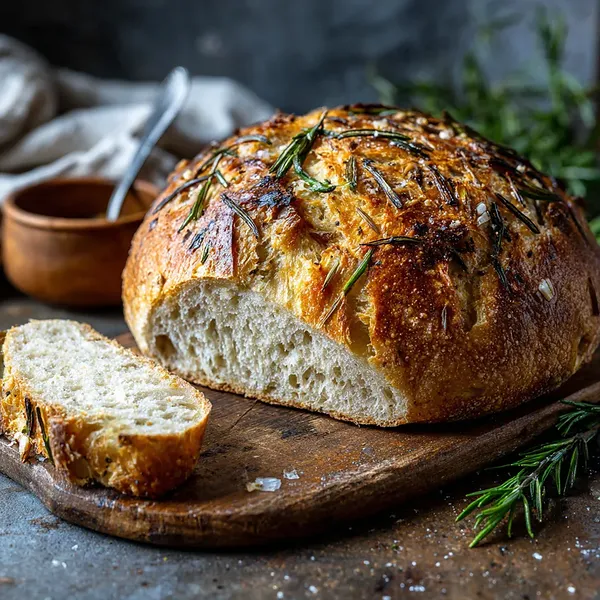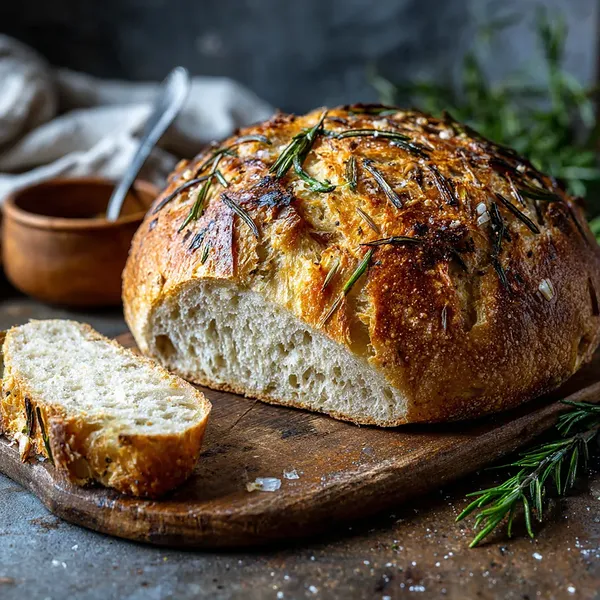 pin it
pin it
I first encountered focaccia during a trip to a small Italian bakery in Rome, where the baker emerged from the back room carrying a golden, herb-topped masterpiece that looked exactly like this. The way he handled it with such pride and the incredible aroma that wafted through the shop left an indelible impression on me. This recipe recreates that exact experience - the perfectly crispy yet tender texture, the aromatic rosemary that perfumes every bite, and that gorgeous golden color that comes from quality olive oil and proper technique. What I love about making this bread is how it transforms simple ingredients into something truly spectacular. The process itself is meditative - mixing the dough, watching it rise, dimpling the surface with your fingertips, and arranging the rosemary sprigs like little green jewels. When you slice into it, you hear that satisfying crackle of the crust giving way to reveal the soft, airy interior with its irregular holes - the hallmark of perfectly fermented dough. Each bite delivers a burst of herbal flavor from the rosemary, balanced by the richness of olive oil and the bright pop of sea salt. It's rustic yet refined, simple yet sophisticated - everything good bread should be.
Why I love this recipe
What I absolutely adore about this rosemary focaccia is how it manages to be both incredibly impressive and surprisingly approachable. There's something deeply satisfying about creating such a beautiful, artisanal-looking bread from just a handful of simple ingredients. The magic happens in the technique - the long, slow rise that develops complex flavors, the gentle dimpling that creates those characteristic wells for the olive oil to pool, and the careful arrangement of rosemary that makes each loaf a work of art. I love how this recipe connects me to generations of Italian bakers who have perfected this craft. The smell alone transports me to Mediterranean hillsides covered in wild rosemary. But beyond the romance of it all, this focaccia is incredibly versatile and forgiving. The dough is relatively easy to work with, and even if your shaping isn't perfect, it still comes out looking rustic and beautiful. Every time I make it, I'm amazed by how something so simple can bring such joy - watching people's faces light up when they taste that first warm, herb-scented bite never gets old. It's the kind of recipe that makes you feel like a real baker, even if you're just starting your bread-making journey.
What You Need From Your Kitchen
- Bread flour: provides the protein structure for a chewy, tender crumb
- Active dry yeast: ferments the dough and creates the airy texture
- Extra virgin olive oil: adds richness, flavor, and creates the golden crust
- Fresh rosemary: provides the signature aromatic herb flavor
- Coarse sea salt: enhances flavor and adds textural contrast on top
- Garlic: adds depth and complements the rosemary beautifully
Let's Make These Together
- Prepare the foundation
- Start by activating your yeast in warm water with a touch of sugar. This step ensures your bread will have the perfect rise and texture. Once foamy, combine with flour and begin building your dough.
- Develop the gluten
- Knead the dough thoroughly until it becomes smooth and elastic. This process develops the gluten structure that will give your focaccia its characteristic chewy yet tender texture.
- Allow proper fermentation
- Let the dough rise slowly in a warm environment. This extended fermentation develops complex flavors and creates the open crumb structure that makes focaccia so special.
- Shape and proof
- Gently transfer the risen dough to your prepared pan and stretch to fit. Allow for a second rise to create maximum fluffiness and air pockets throughout the bread.
- Create the signature dimples
- Use your fingertips to create deep wells across the surface. These dimples are essential for holding the olive oil and creating the rustic, artisanal appearance of authentic focaccia.
- Add the finishing touches
- Drizzle generously with olive oil, press in fresh rosemary sprigs, and finish with coarse sea salt. These final additions transform simple bread into an aromatic masterpiece.
 pin it
pin it
Switch Things Up
Last Sunday, I decided to make this focaccia for a family gathering, and it completely stole the show. I remember kneading the dough early in the morning, the kitchen windows fogged with steam from the warm water I used to activate the yeast. As the dough rose, I picked fresh rosemary from my herb garden - the scent on my fingers was intoxicating. When I pressed those rosemary sprigs into the oiled surface and sprinkled the coarse sea salt on top, I knew something magical was about to happen. The aroma that filled the house as it baked was absolutely divine. My family kept wandering into the kitchen, drawn by the smell. When I finally pulled it from the oven, golden and crackling, there was this moment of pure satisfaction. We ate it warm, tearing off pieces with our hands, the olive oil still glistening on the crust. It disappeared within minutes, everyone asking when I'd make it again.
Perfect Pairings
This rosemary focaccia pairs beautifully with a variety of foods and occasions. Serve it warm with extra virgin olive oil and balsamic vinegar for dipping as an appetizer. It's exceptional alongside hearty soups like minestrone or tomato basil, perfect for soaking up every last drop. For a more substantial meal, use it as the base for sandwiches filled with fresh mozzarella, tomatoes, and basil. It also complements charcuterie boards wonderfully, providing a rustic bread element that pairs with cured meats and aged cheeses. During summer, it's delightful with fresh bruschetta toppings or simply enjoyed with a glass of Chianti while watching the sunset.
 pin it
pin it
Frequently Asked Questions
- → How do I know if my yeast is active?
Active yeast will become foamy and bubbly within 5-10 minutes of being mixed with warm water and sugar. If it doesn't foam, your yeast may be expired or the water too hot.
- → Can I make this without a stand mixer?
Absolutely! This recipe is designed for hand kneading. Just knead the dough on a floured surface for 8-10 minutes until smooth and elastic.
- → How should I store leftover focaccia?
Store covered at room temperature for 2-3 days, or freeze for up to 3 months. Reheat in a 350°F oven for 5-10 minutes to restore crispness.
- → Can I use dried rosemary instead of fresh?
Fresh rosemary is strongly recommended for the best flavor and appearance. If using dried, use about 1 tablespoon and add it to the dough rather than on top.
- → Why is my focaccia not rising properly?
Check that your yeast is fresh and active, the water temperature is around 105-110°F, and you're letting it rise in a warm, draft-free environment.
Conclusion
This rosemary focaccia is more than just bread - it's an experience that transforms your kitchen into an Italian bakery. The combination of crispy crust, tender crumb, and aromatic herbs creates the perfect accompaniment to any meal. Whether served as an appetizer with olive oil for dipping, alongside soup, or as the foundation for sandwiches, this focaccia never fails to impress. The beauty of this recipe lies in its simplicity and the way it allows the quality ingredients to shine through every golden, herb-scented bite.
